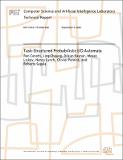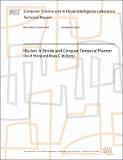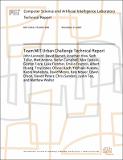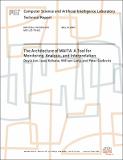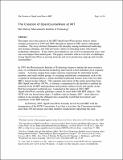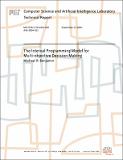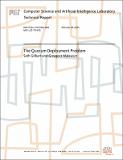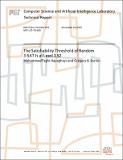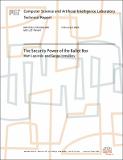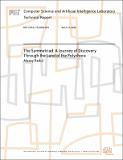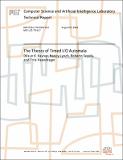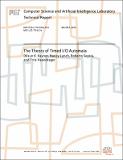Browsing CSAIL Digital Archive by Title
Now showing items 705-724 of 806
-
Table 1 (Supplemental): Summary of expression programs discovered by GeneProgram from Novartis Tissue Atlas v2 data
(2007-06-25)Table 1 (Supplemental): Summary of recurrent expression programs (EPs) discovered by GeneProgram. The columns are: (1) the EP identifier (an arbitrarily assigned number), (2) the number of genes in the EP, (3) the number ... -
Table 2 (Supplemental): Complete data for all 100 expression programs discovered by GeneProgram from the Novartis Gene Atlas v2
(2007-06-25)Table 2 (Supplemental): Complete data for all 100 recurrent expression programs (EPs) discovered by GeneProgram. Each EP has two identifying rows, a list of meta-genes, and a list of significantly enriched GO categories. ... -
Task-Structured Probabilistic I/O Automata
(2009.)Modeling frameworks such as Probabilistic I/O Automata (PIOA) and Markov Decision Processes permit both probabilistic and nondeterministic choices. In order to use these frameworks to express claims about probabilities of ... -
Task-Structured Probabilistic I/O Automata
(2006-03-31)In the Probabilistic I/O Automata (PIOA) framework, nondeterministicchoices are resolved using perfect-information schedulers,which are similar to history-dependent policies for Markov decision processes(MDPs). These ... -
Task-Structured Probabilistic I/O Automata
(2006-09-05)Modeling frameworks such as Probabilistic I/O Automata (PIOA) andMarkov Decision Processes permit both probabilistic andnondeterministic choices. In order to use such frameworks to express claims about probabilities of ... -
tBurton: A Divide and Conquer Temporal Planner
(2014-10-24)Planning for and controlling a network of interacting devices requires a planner that accounts for the automatic timed transitions of devices while meeting deadlines and achieving durative goals. For example, a planner for ... -
Team MIT Urban Challenge Technical Report
(2007-12-14)This technical report describes Team MIT’s approach to theDARPA Urban Challenge. We have developed a novel strategy forusing many inexpensive sensors, mounted on the vehicle periphery,and calibrated with a new cross-modal ... -
Temporally Scalable Visual SLAM using a Reduced Pose Graph
(2012-05-25)In this paper, we demonstrate a system for temporally scalable visual SLAM using a reduced pose graph representation. Unlike previous visual SLAM approaches that use keyframes, our approach continually uses new measurements ... -
The Tensor Algebra Compiler
(2017-02-17)Tensor and linear algebra is pervasive in data analytics and the physical sciences. Often the tensors, matrices or even vectors are sparse. Computing expressions involving a mix of sparse and dense tensors, matrices and ... -
The Architecture of MAITA: A Tool for Monitoring, Analysis, and Interpretation
(2004-05-18)This report describes the aims, functions, and organization of the MAITAsystem for knowledge-based construction, adaptation, and control of networks of monitoringprocesses. -
The Creation of OpenCourseWare at MIT
(2007-05-19)This paper traces the genesis of the MIT OpenCourseWare project from its initial strategic precursors in 1999 and 2000, through its launch in 2001 and its subsequent evolution. The story told here illuminates the interplay ... -
The Design of a Relational Engine
(2006-09-29)The key design challenges in the construction of a SAT-based relational engine are described, and novel techniques are proposed to address them. An efficient engine must have a mechanism for specifying partial solutions, ... -
The Interval Programming Model for Multi-objective Decision Making
(2004-09-27)The interval programming model (IvP) is a mathematical programmingmodel for representing and solving multi-objective optimizationproblems. The central characteristic of the model is the use ofpiecewise linearly defined ... -
The Psychophysiology of Risk Processing and Decision Making at a Regional Stock Exchange
(2007-06-12)A longstanding controversy in philosophy is whether decision-making isgoverned by reason or emotion. I study the role of physiologicalresponses in the decision-making process within the realm of financialmarkets, where ... -
The Quorum Deployment Problem
(2004-10-29)Quorum systems are commonly used to maintain the consistency of replicated data in adistributed system. Much research has been devoted to developing quorum systems with good theoreticalproperties, such as fault tolerance ... -
The Satisfiability Threshold of Random 3-SAT Is at Least 3.52
(2003-11-20)We prove that a random 3-SAT instance with clause-to-variable densityless than 3.52 is satisfiable with high probability.The proof comes through an algorithm which selects (and sets) a variabledepending on its degree and ... -
The Security Power of the Ballot Box
(2005-02-02)We show that any function F can be securely evaluated by a protocolwith ballots and a ballot box. That is, N mutually suspicious players,each player possessing a secret input, can use ballots and a ballotbox to jointly ... -
The Symmetriad: A Journey of Discovery Through the Land of the Polychora
(2005)I devised and implemented a method for constructing regular andsemiregular geometric objects in n-dimensional Euclidean space.Given a finite reflection group (a Coxeter group) G, there is a standard way to give G a group ... -
The Theory of Timed I/O Automata
(2003-08-27)Revised version -- November 23, 2004.This paper presents the Timed Input/Output Automaton (TIOA) modeling framework, a basic mathematical framework to support description and analysis of timed systems. -
The Theory of Timed I/O Automata
(2005-03-02)This monograph presents the Timed Input/Output Automaton (TIOA) modeling framework, a basic mathematical framework to support description and analysis of timed systems.



